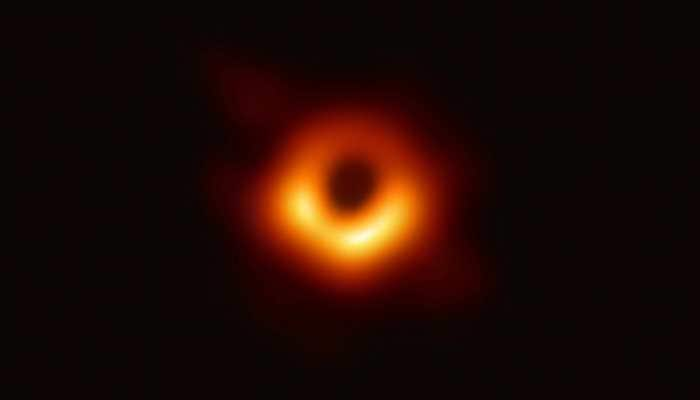Gravitational Lensing helps discover Dark Matter distribution in Universe
Gravitational lensing is the most direct technique that can help reveal the principal mass component of the Universe, Dark Matter distribution, which makes up about 80% of the mass budget.
Trending Photos
)
 Washington: Gravitational lensing is the most direct technique that can help reveal the principal mass component of the Universe, Dark Matter distribution, which makes up about 80% of the mass budget.
By following Einstein`s theory of Gravitation, it`s well known that a mass concentration would deform locally the Space-Time and the observed shapes of distant galaxies seen through the concentration would be deflected and distorted. By measuring the exact shapes of millions of these distant galaxies the mass distribution in the Universe could be mapped accurately and the mass peaks tracing mass concentration along their line of sight would be identified.
In particular this distribution would be sensitive to the nature of Gravitational force at large scales as well as the geometry of the Universe. Measuring mass peaks would thus be one of the most attractive ways to explore the relative importance and nature of Dark Matter and Dark Energy.
This map showed the distribution of dark matter (black) in the Universe, overlapping with optical measured clusters of galaxies (red circles). The mass peaks in the map contain significant cosmological information. The size of this map was about 4 square degrees corresponding to only 2.5percent of the full CS82 survey footprint shown in the next figure.
The international team, comprising researchers from Swiss, France, Brazil, Canada, and Germany presented the first detailed analysis of the weak lensing peaks and it was considered as a milestone because mass peaks were identified in two-dimensional dark matter maps directly, they could provide constraints that were free from potential selection effects and biases involved in identifying and measuring the masses of galaxy clusters. In fact a small fraction of the max peaks are just mass concentration excess along the line of sight, and not genuine massive clusters.
The research team used the Canada-France-Hawaii Telescope Stripe 82 Survey (CS82 in short), still one of the largest weak lensing survey yet. The Survey covers 170 square degrees of the Stripe 82 of the Sloan Digital Sky Survey (SDSS), an equatorial region of the South Galactic Cap that has been extensively studied by the SDSS project.
Jean-Paul Kneib, said that this work opened up a new window to constrain cosmology with weak gravitational lensing and they could not only reveal where the dark matter was located using space-time distortion, but also use the distributions of mass peaks to better constrain and understand the Universe better.
The study is published in the Monthly Notice of Royal Astronomical Society.
Washington: Gravitational lensing is the most direct technique that can help reveal the principal mass component of the Universe, Dark Matter distribution, which makes up about 80% of the mass budget.
By following Einstein`s theory of Gravitation, it`s well known that a mass concentration would deform locally the Space-Time and the observed shapes of distant galaxies seen through the concentration would be deflected and distorted. By measuring the exact shapes of millions of these distant galaxies the mass distribution in the Universe could be mapped accurately and the mass peaks tracing mass concentration along their line of sight would be identified.
In particular this distribution would be sensitive to the nature of Gravitational force at large scales as well as the geometry of the Universe. Measuring mass peaks would thus be one of the most attractive ways to explore the relative importance and nature of Dark Matter and Dark Energy.
This map showed the distribution of dark matter (black) in the Universe, overlapping with optical measured clusters of galaxies (red circles). The mass peaks in the map contain significant cosmological information. The size of this map was about 4 square degrees corresponding to only 2.5percent of the full CS82 survey footprint shown in the next figure.
The international team, comprising researchers from Swiss, France, Brazil, Canada, and Germany presented the first detailed analysis of the weak lensing peaks and it was considered as a milestone because mass peaks were identified in two-dimensional dark matter maps directly, they could provide constraints that were free from potential selection effects and biases involved in identifying and measuring the masses of galaxy clusters. In fact a small fraction of the max peaks are just mass concentration excess along the line of sight, and not genuine massive clusters.
The research team used the Canada-France-Hawaii Telescope Stripe 82 Survey (CS82 in short), still one of the largest weak lensing survey yet. The Survey covers 170 square degrees of the Stripe 82 of the Sloan Digital Sky Survey (SDSS), an equatorial region of the South Galactic Cap that has been extensively studied by the SDSS project.
Jean-Paul Kneib, said that this work opened up a new window to constrain cosmology with weak gravitational lensing and they could not only reveal where the dark matter was located using space-time distortion, but also use the distributions of mass peaks to better constrain and understand the Universe better.
The study is published in the Monthly Notice of Royal Astronomical Society.Stay informed on all the latest news, real-time breaking news updates, and follow all the important headlines in india news and world News on Zee News.
Advertisement
Live Tv
Advertisement







)
)
)
)
)
)
)
)
)
)
